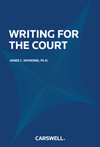The title of this book is deliberately ambiguous. Judges write for the court. Their clerks write for the court. But counsel, too, are most effective when they write for the court – that is, when they assist the court in producing judgments that are persuasive, just, and likely to withstand scrutiny on appeal. For this reason, the structural, stylistic, and analytical advice given in this book applies equally to writers on both sides of the bench. The advice applies equally to common law and civil law jurisdictions.
Writing for the Court consists of two sections: Practice and Theory. The advice given in Part I is both practical and original, emphasizing the importance of issue-identification as the first step in preparing a submission or a judgment. The pattern of organisation proposed in this section will assist judges and lawyers in solving their most vexing challenge: reducing the chaos of litigation to a concise, clear, and coherent analysis.
Part II explains a radically innovative theory of language, law, and logic, placing legal reasoning between the more precise disciplines of science and mathematics and the freewheeling discourse of literature. Ultimately, these chapters explain why competent and impartial jurists can draw opposite inferences from the same combination of evidence and law. Culminating in a description of what the author calls “legal existentialism”, these chapters provide an antidote to the most lethal intellectual disease of our times – fundamentalism in all its forms – with implications for ethics, jurisprudence, and legal education.
Contents
- Preface
- Table of Cases
- Part I: PRACTICE - Why Can’t Lawyers Write like Katherine Mansfield. An analysis of the occasional flirtation between law and literature. Structure Before Style. A structural template for judgments and pleadings, along with a five-step process for organisation and analysis. It Ain’t What You Do. Elements of style and usage that become relevant only after content, structure, and logic have been attended to.
- Part II: THEORY - Language, Logic, and the Logosphere. An original theory of language and a taxonomy of discourse in which legal reasoning is seen to be uniquely equipped to address questions beyond the realms of logic and science. Saving the Literal: Soft Logic in Statutory Interpretation. An analysis of tropes of soft logic that are masked by traditional codes and canons of textural interpretation. Law, Literature, and Legal Existentialism. A provocative theory of existential ethics and its public expression as law. Paradoxes, Implications, and Applications. The role of an independent judiciary, along with a qualified defence of illusions of certitude created by jurisprudence and practical implications for legal education.
- Works Cited and Additional Reading
- Index
Jurisdiction: International
The title of this book is deliberately ambiguous. Judges write for the court. Their clerks write for the court. But counsel, too, are most effective when they write for the court – that is, when they assist the court in producing judgments that are persuasive, just, and likely to withstand scrutiny on appeal. For this reason, the structural, stylistic, and analytical advice given in this book applies equally to writers on both sides of the bench. The advice applies equally to common law and civil law jurisdictions.
Writing for the Court consists of two sections: Practice and Theory. The advice given in Part I is both practical and original, emphasizing the importance of issue-identification as the first step in preparing a submission or a judgment. The pattern of organisation proposed in this section will assist judges and lawyers in solving their most vexing challenge: reducing the chaos of litigation to a concise, clear, and coherent analysis.
Part II explains a radically innovative theory of language, law, and logic, placing legal reasoning between the more precise disciplines of science and mathematics and the freewheeling discourse of literature.


